Scotland is one of the four major political divisions that make up the United Kingdom of Great Britain and Northern Ireland. The other divisions are England, Northern Ireland, and Wales. Edinburgh is the capital of Scotland, and Glasgow is the largest city.
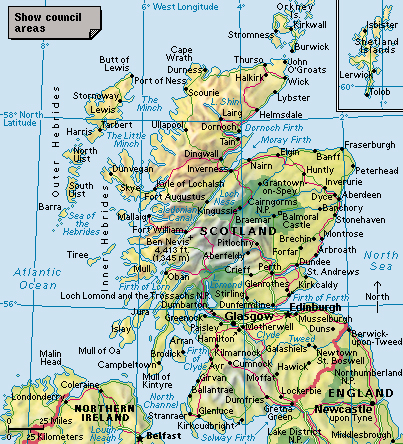
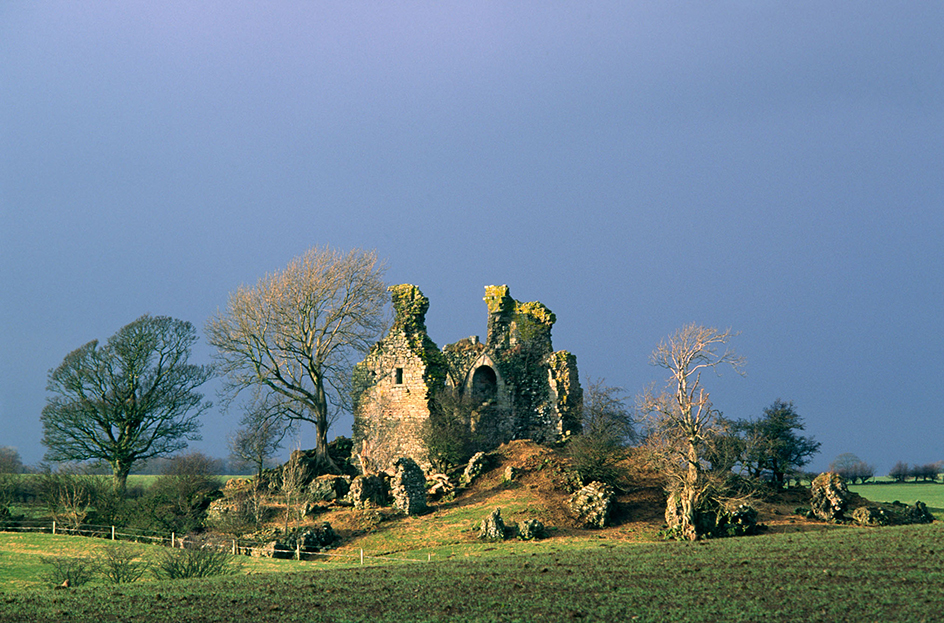
Scotland occupies the northern third of the island of Great Britain. Most of Scotland is mountainous. Its rugged mountains, green valleys, and deep, blue lakes provide some of the most beautiful scenery in Europe.
Most of the Scottish people live in central Scotland, where the land is flatter and more fertile. Many Scots work in service industries (economic activities that provide services rather than produce goods). Service industries and manufacturing form the basis of the economy in Scotland.
The Scottish people have long been famous for their close-knit clans (groups of related families), colorful plaid kilts, and skill as fierce warriors. But the clans have lost much of their importance, kilts are worn mainly for ceremonial occasions, and no conventional war has been fought in Scotland for more than 200 years.
Scotland was an independent state until the Act of Union of 1707, which joined Scotland with England and Wales as a “united kingdom of Great Britain.” Scotland now has a strong separatist movement, led by the Scottish National Party. In a referendum (direct vote) in 1997, voters in Scotland approved plans for the Scottish Parliament, which met for the first time in 1999. The government of the United Kingdom devolved (transferred) some of its powers to the government of Scotland. In 2014, Scottish voters defeated a referendum that would have made Scotland an independent nation.
People
Population.
About three-quarters of Scotland’s people live in the lowlands of central Scotland, a region that makes up only about a sixth of Scotland’s mainland area. The rugged Highlands and the hilly uplands of southern Scotland are more sparsely populated. The Highlands, which cover about two-thirds of the Scottish mainland, have some of the most thinly populated areas in Scotland. Less than 2 percent of the people live in the three island areas of Orkney, Shetland, and the Western Isles.


One of Scotland’s major problems has been emigration. From the mid-1800’s to the 1960’s, Scotland experienced several waves of mass emigration. Many of these people left Scotland because of limited job opportunities. Many areas of Scotland have focused on promoting tourism and developing local businesses to help reduce emigration. New industries, such as the production of oil from the North Sea, have helped provide more jobs. In the late 1990’s and early 2000’s, immigration to Scotland increased.
Ancestry.
Most Scottish people are descended from peoples who came to Scotland more than 1,000 years ago. These groups included the Celts, Scandinavians, and a Celtic tribe from Ireland called the Scots. Each group influenced Scottish civilization.
Language.
English is the official language throughout the United Kingdom. In Scotland, English is spoken in a variety of dialects.
About 2 percent of Scots have some knowledge of Gaelic, an ancient Celtic language. Many of these people live in the Highlands or on the islands west of the mainland. See Gaelic languages .
Way of life
Industrialization has eliminated many of Scotland’s old traditions and ways of life. Many fortified castles still stand in Scotland, remnants of its warlike past. But day-to-day living in Scotland is much like that in other parts of the United Kingdom and Europe. Today, most Scots are wage earners who live in or near cities.
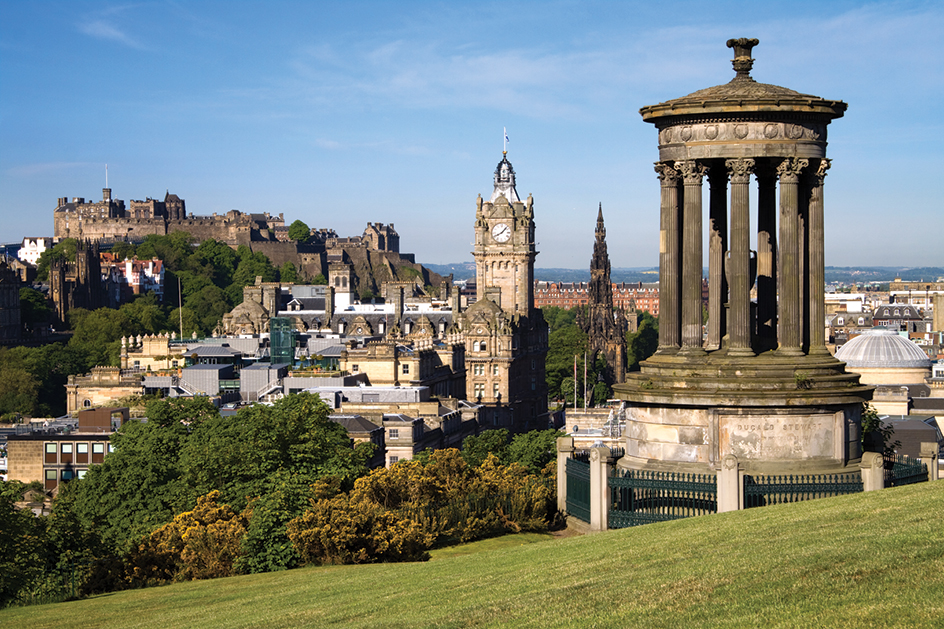
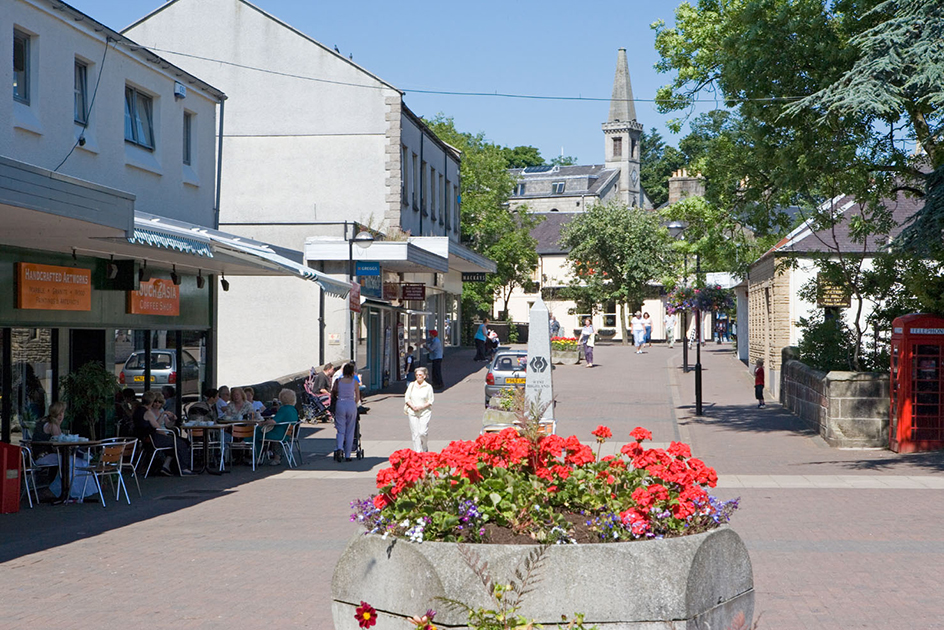
City life.
Small homes, terrace houses, and apartment buildings made of stone are common in Scotland’s cities. Many Scottish cities developed around coal mining and heavy industry during the 1800’s and early 1900’s. Much of the housing then was of poor quality. Beginning in the late 1940’s, the government began extensive efforts to improve living conditions in Scotland. It replaced much of the run-down housing with modern, publicly owned apartment buildings and houses. The councils that oversee the local government areas manage the publicly owned dwellings, which are called council flats and council houses. By the early 2000’s, privately owned housing was becoming more popular than publicly owned housing in Scotland.
Crowding and pollution are rare in Scottish cities, partly because Scotland’s heavy industry has declined. Glasgow ranked as a great industrial and commercial center in the late 1800’s and early 1900’s. It was known as the Second City of the British Empire, London being the first city. To ease crowding in Glasgow after World War II (1939-1945), the government built five planned communities called new towns, including East Kilbride and Cumbernauld, in the Central Lowlands. Although much heavy industry closed in the mid-1900’s, new industries in light manufacturing and other fields developed. The new industries helped Glasgow and the Central Lowlands remain as the industrial center of Scotland. But some towns in the area still face high unemployment rates.
The city of Aberdeen, on the east coast of Scotland, has experienced great growth and prosperity since the 1970’s. This growth is mostly due to the opening of offshore oil and gas fields under the North Sea. The oil industry provides many jobs and brings much money to the area. It has made Aberdeen the oil capital of Europe.
Rural life.
Much of Scotland’s countryside has rugged terrain and offers only a limited number of jobs and resources. Some rural workers fish, grow crops, raise livestock, or harvest timber. However, only about 3 percent of Scotland’s employed people earn their living in farming, fishing, and forestry. Many rural dwellers commute to jobs in the cities. 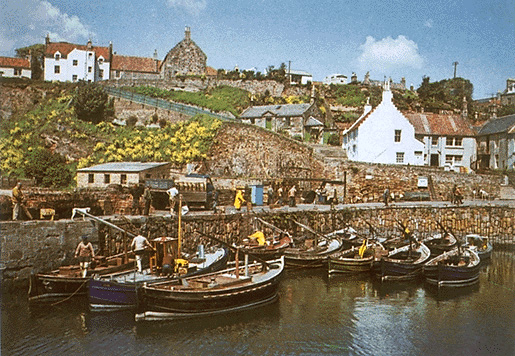

The distinction between urban and rural communities in Scotland is often blurred. As a result of better transportation and greater contact with the cities, rural communities have become less distinctive and their people less close-knit. As in the cities, housing in rural areas greatly improved during the late 1900’s. Fewer rural people live in apartments, but otherwise housing and social conditions in urban and rural areas are similar. Scotland has some remote rural areas with limited access and services.
Food and drink.
Favorite foods and beverages in Scotland resemble those in other parts of the United Kingdom. Most Scottish cooking is simple. Favorite traditional Scottish dishes include fish and chips, herring, roast beef, and roast lamb. The Scots also enjoy fine steaks from Scotland’s famous Aberdeen-Angus cattle.
Other traditional Scottish foods include haggis , kippers, porridge, and salmon. Haggis is a famous national dish made from the heart, liver, and lungs of a sheep. These ingredients are chopped with suet (animal fat), onions, porridge, and seasonings, and then boiled in a bag made from a sheep’s stomach. Kippers are smoked herring, a traditional breakfast dish. Oatmeal is used in many Scottish dishes, including porridge and oatcakes (flat cakes cooked on a griddle), both of which are popular for breakfast. Salmon is served smoked, grilled, or poached. Salmon taken from Scottish waters is considered one of the world’s tastiest fishes.
In addition to traditional Scottish dishes, other foods, such as hamburgers, pizzas, and curries (stews spiced with curry), are popular in Scotland. Tea is also popular. The number of Scots who drink coffee has increased greatly since the mid-1900’s.
One of the favorite alcoholic drinks in Scotland is Scotch whisky, or Scotch. The Scots have been making whisky since the 1400’s. They export about 175 million gallons (660 million liters) of Scotch yearly.
Recreation.
Most Scots enjoy sports and outdoor activities. Scotland’s huge open lands make excellent recreational areas.
The Scots probably developed the modern game of golf, and it is still one of their favorite games. Scotland’s numerous golf courses include the world-famous Royal and Ancient Golf Club of St. Andrews. See Golf (History) . 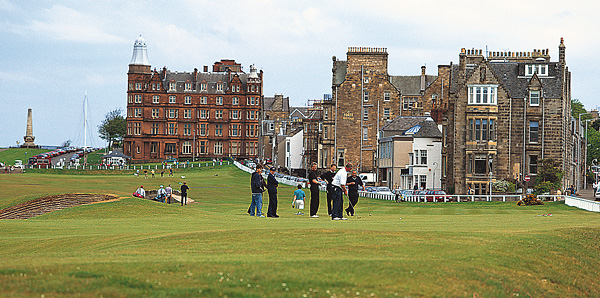
Scotland’s most popular organized sport is association football, or soccer. Professional teams play in the Scottish Football League and in European competitions. Rugby football is also popular in Scotland.
The Highland Games, gatherings that feature athletic competitions and traditional music and dancing, are held throughout the Highlands during the spring, summer, and early autumn. Field events include tossing the caber, a long wooden pole that weighs about 180 pounds (82 kilograms). Athletes compete to see who can heave the caber the straightest. Other events of the Highland Games include footraces and dancing and bagpipe competitions. The British royal family traditionally attends the games held in Braemar.
People from throughout the world come to fish for trout and salmon in the clear mountain streams of the Highlands. Hiking, mountain climbing, and shooting are also popular, especially in the Highlands. The Cairngorm Mountains southeast of Inverness and the area around Ben Nevis in western Scotland are among the best mountain-climbing regions in Europe.
Popular winter sports in Scotland include skiing and curling. Curling is a game in which the players slide heavy stones across a sheet of ice toward a target.
Education.
Scotland’s system of education is separate from that of England and Wales and from that of Northern Ireland. The Scottish Office Education Department and local education authorities supervise the school system in Scotland.
All Scottish children between the ages of 5 and 16 must attend school. Nearly all schools are supported by public funds. Scotland also has private schools, including some well-known institutions in Edinburgh.
For many years, Scotland had separate schools for vocational and academic education. But during the 1970’s, these specialized schools were replaced with comprehensive schools. Comprehensive schools provide both types of education, and students take courses geared to their abilities.
The oldest institutions of higher education in Scotland are the universities at Aberdeen, Glasgow, and St. Andrews, all founded in the 1400’s. Edinburgh and Glasgow are the largest universities. Other Scottish universities include Abertay, Dundee, Glasgow Caledonian, Heriot-Watt, Napier, Paisley, Robert Gordon, Stirling, and Strathclyde.
Religion.
The Church of Scotland, a Presbyterian church, is the official church. But the people may worship as they choose. Many Scots are Baptists, Episcopalians, Methodists, Roman Catholics, or members of Presbyterian churches other than the Church of Scotland.
The Church of Scotland has about 2 million members. The members elect ministers and elders (officers) of the church to the General Assembly of the Church of Scotland, which meets once a year. The assembly is often called the Voice of Scotland because it discusses national and world affairs as well as church matters. The British monarch may attend the assembly.
The arts.
Scotland has produced many famous artists, especially in the field of literature. The earliest Scottish literature was chiefly oral. It was sung or chanted by poet-singers called bards, who composed poetry and songs in the Gaelic language.
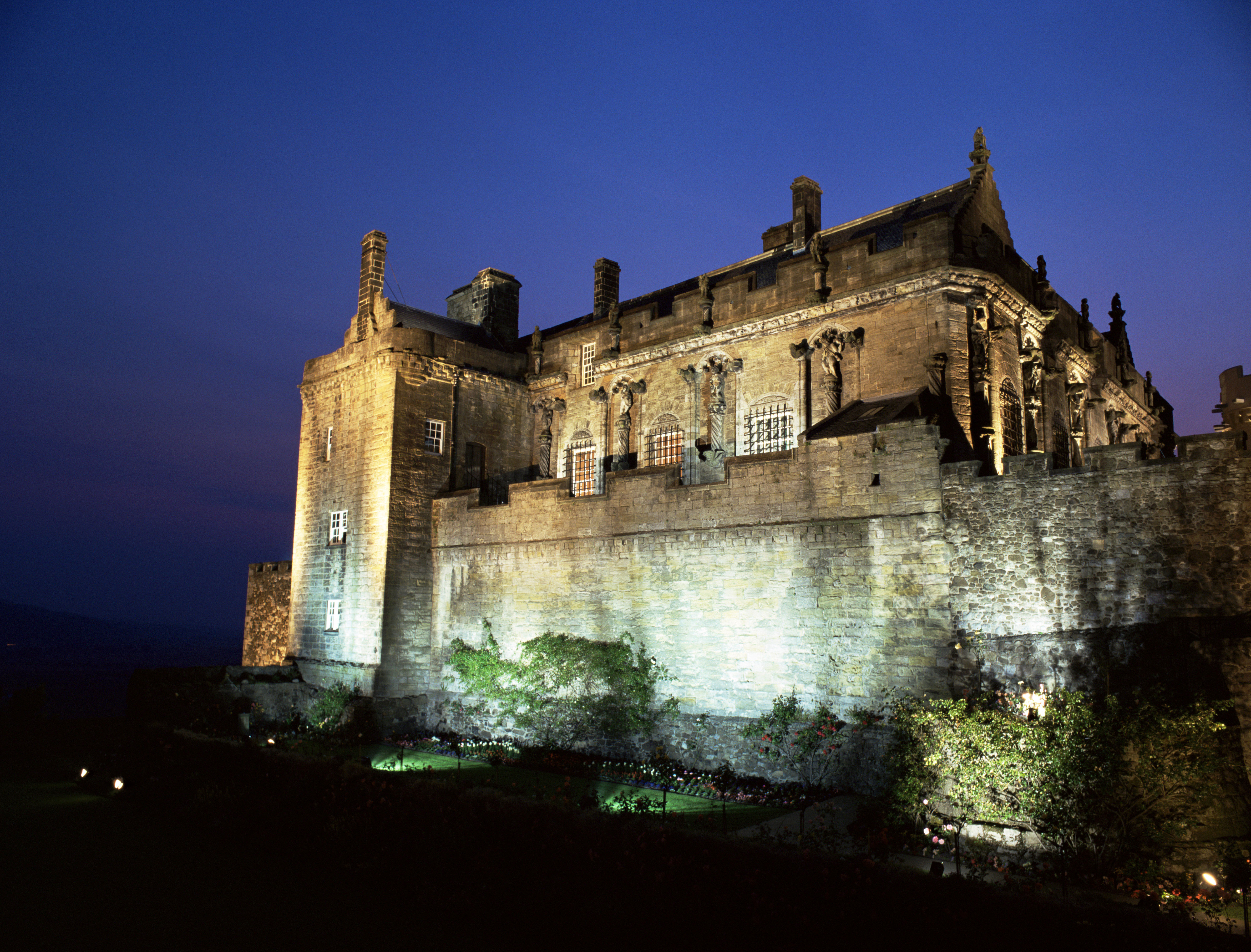
Between the 1300’s and 1700’s, famous Scottish poets included John Barbour, Gavin Douglas, William Dunbar, and Allan Ramsay. Robert Burns, who wrote during the late 1700’s, became the national poet of Scotland. He wrote many works in Scots, the Scottish dialect used in literature. Many modern Scottish poets, including Hugh McDiarmid, Tom Scott, and Douglas Young, have also used Scots.
Most Scottish prose is written in English. Famous Scottish authors of the 1700’s include James Boswell, who wrote a fascinating biography of the English writer Samuel Johnson, and John Arbuthnot, who wrote many great essays. In the 1800’s, Thomas Carlyle produced brilliant histories and biographies, and John Lockhart became known for his works of literary criticism. Scotland’s best-known novelists, Sir Walter Scott and Robert Louis Stevenson, also wrote during the 1800’s. Scott’s most famous work is Ivanhoe (1819). Stevenson’s novels include Treasure Island (1883) and Kidnapped (1886). The Scottish writer J. M. Barrie wrote Peter Pan (1904) and other popular plays.
Scotland’s first important painters were the portrait painters Allan Ramsay (the son of the poet of the same name) and Sir Henry Raeburn, who lived in the 1700’s and early 1800’s. In the early 1800’s, Sir David Wilkie painted scenes from history and everyday life. Famous painters of the late 1800’s include William MacTaggart, known for his seascapes and landscapes; and Sir William Orchardson and John Pettie, who specialized in literary and historical subjects. Leading Scottish painters of the late 1800’s and early 1900’s included the portrait painter Sir James Guthrie and W. Y. Macgregor, who produced realistic landscapes and scenes of everyday life.
Scottish music has traditionally centered on the bagpipe. The Scots divide bagpipe music into big music and little music. Big music includes warlike or sad songs called pibrochs. Little music includes marches and music for dancing. The Scottish reel, the Highland fling, the sword dance, and other traditional dances are performed to little music. The Edinburgh International Festival of the Arts, held in Edinburgh each August, features musical and dramatic productions. Loading the player...
Scottish traditional march
The land
Scotland occupies the northern third of the island of Great Britain. The River Tweed and the Cheviot Hills form Scotland’s southern border with England. The North Channel separates southwestern Scotland from Northern Ireland. The northwest coast faces the Atlantic Ocean. The east coast faces the North Sea, which separates Scotland from the mainland of Europe. For information on Scotland’s climate, see the table with the Climate section of United Kingdom .
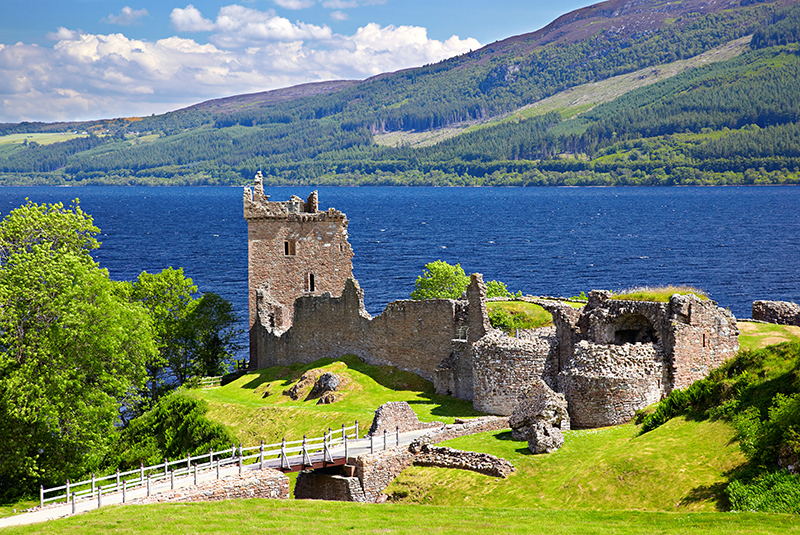
Land regions.
Scotland has three main land regions. They are, from north to south, the Highlands, the Central Lowlands, and the Southern Uplands.
The Highlands
are a rugged, barren region that covers the northern two-thirds of Scotland. Two major mountain ranges, the Northwest Highlands and the Grampian Mountains, rise in this region. The ranges have parallel ridges that run through the Highlands from northeast to southwest. A deep valley called Glen Mor (the Great Glen) separates the two mountain ranges. The highest peak in the United Kingdom, 4,413-foot (1,345-meter) Ben Nevis, rises south of Glen Mor. The Highlands have two kinds of valleys—steep, narrow glens and broad, rolling straths. Much of the land in the Highlands is a treeless area called a moor or heath. The most rugged land lies along the west coast. Most Highlanders live on the narrow coastal plains.
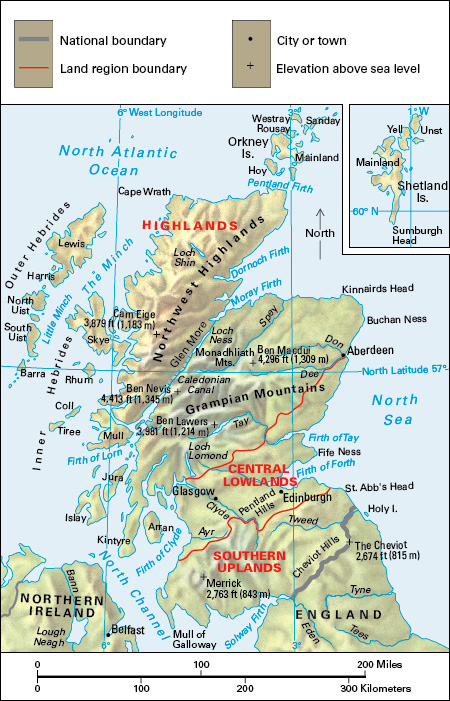
The Central Lowlands
are crossed by the valleys of the Rivers Clyde, Forth, and Tay. This region has Scotland’s best farmland. Wide, fertile fields and low hills with patches of trees cover the region. About three-quarters of the Scottish population live in the lowlands.
The Southern Uplands
consist of rolling moors, broken in places by rocky cliffs. The tops of the hills are largely barren, but rich pastureland covers most of the lower slopes. Farmers raise many sheep and cattle in the Southern Uplands. In the south, the uplands rise to the Cheviot Hills.
Rivers and lakes.
The River Clyde is Scotland’s most important river. Ships from the Atlantic Ocean can sail up the Clyde to Glasgow, although large container ships do not go beyond Greenock. The Clyde was narrow and shallow until the 1700’s, when engineers widened and deepened the river to make it navigable. Scotland’s longest rivers flow eastward into the North Sea. The Tay, 120 miles (193 kilometers) long, is the longest river in Scotland. 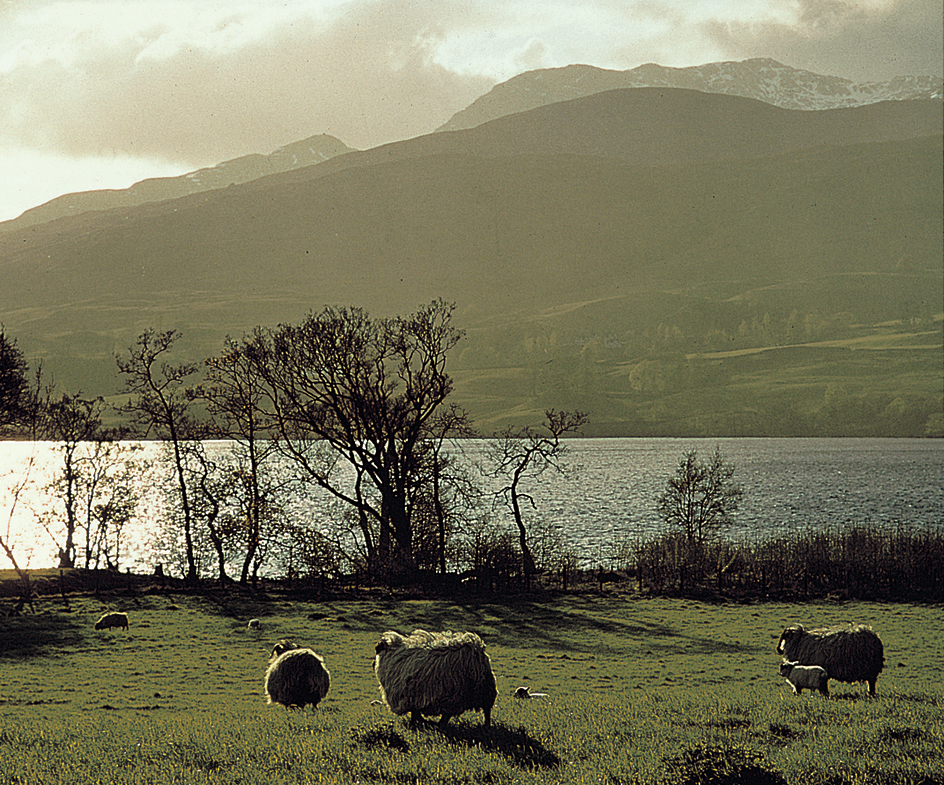

Many of Scotland’s rivers flow into wide bays called firths. The firths of Clyde and Lorn lie on the west coast. The firths of Forth and Tay and the Moray Firth are on the east coast. All ships bound for Glasgow must pass through the Firth of Clyde. Road traffic crosses the Firth of Forth at Queensferry on a suspension bridge, which hangs from cables that are supported by two high towers. A cantilever bridge for trains also spans the Firth of Forth. The bridge, built in 1890, is one of the finest examples of cantilever construction, consisting of two halves that extend from opposite banks, each standing without support from the other.
Most of Scotland’s lakes, which are called lochs, lie in deep Highland valleys. Loch Lomond is Scotland’s largest lake. It is 23 miles (37 kilometers) long and 5 miles (8 kilometers) wide at its widest point. A series of lakes extends through Glen Mor. These lakes are connected by canals and form the Caledonian Canal, which cuts across Scotland from Moray Firth to the Firth of Lorn. One of the canal’s lakes, Loch Ness, is famous for its “monster.” Some people claim to have seen a creature 30 feet (9 meters) long in the lake. Along the west coast, the Atlantic Ocean extends inland in many narrow bays called sea lochs.
Islands.
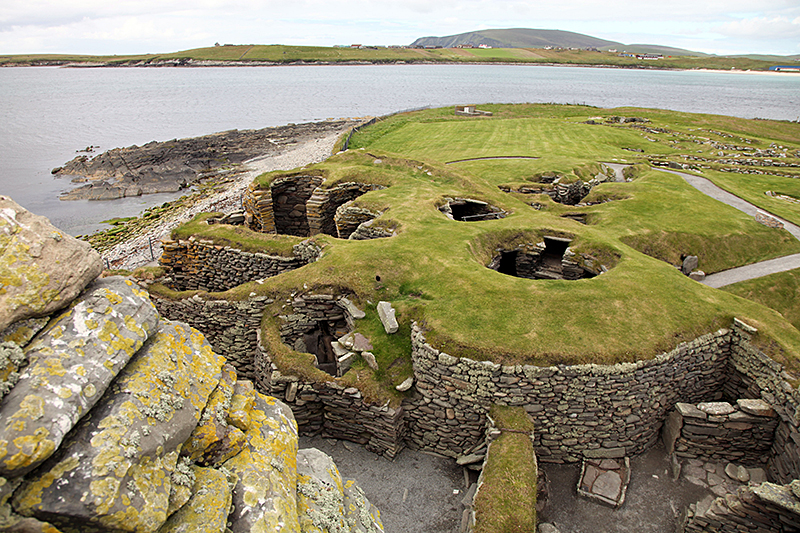
Scotland has hundreds of islands. A large group of islands called the Hebrides lies off the west coast of Scotland’s mainland. These are divided into the inner and outer groups, separated by a seaway known as the Minch. The Orkney and Shetland groups lie north of the mainland and form the boundary between the North Sea and the Atlantic Ocean.
Economy
In the late 1800’s and the first half of the 1900’s, large numbers of Scots worked in such industries as shipbuilding and engineering. Today, these businesses employ fewer of Scotland’s workers. The economy has shifted greatly from heavy manufacturing to service industries, which provide services rather than goods. Service industries, light manufacturing, and the energy industry provide most of Scotland’s jobs.
Service industries
employ about four-fifths of the labor force in Scotland and account for about three-fourths of Scotland’s economic production. The service industries with the most employees are education, finance and business services, health care, restaurants and hotels, and retail sales. Public administration, transportation, and communications also are major employers.
Manufacturing.
About 5 percent of Scotland’s work force has jobs in manufacturing, which accounts for about 10 percent of Scotland’s economic production. The chief manufactured products include chemicals, electronic equipment, food and beverages, and metal products. Industrial equipment, woolens, and whisky are products for which Scotland has long been famous. The Central Lowlands are the center of the manufacturing industry, but new factories have been built in rural areas.
Agriculture, forestry, and fishing.
About 70 percent of the land in Scotland is used for farming. Most of the land consists of rough grazing, land that farmers use for grazing livestock. Scottish farmers have developed many famous breeds of beef and dairy cattle, including Ayrshire, Aberdeen-Angus, Galloway, and Highland. They also developed the Clydesdale workhorse; the Shetland pony; and a sheepdog, the collie.
Livestock products, such as meat, milk, and wool, account for about two-thirds of Scotland’s farm production. In the northeast, farmers produce much beef. Milk ranks as a major product in the southwest, which is traditionally associated with Ayrshire cattle. Farmers raise Cheviot Scottish Blackface sheep on the grazing land of the Highlands and of southern Scotland. 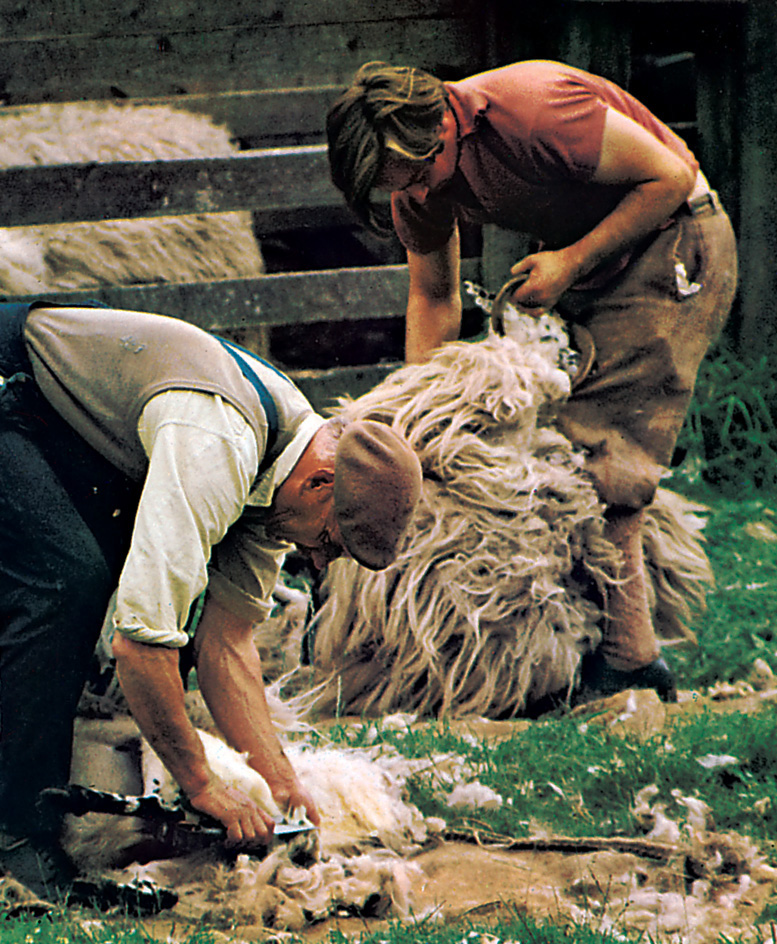
Less than one-fifth of Scotland’s land is suitable for growing crops. Farmers plant mainly grain, including barley, oats, and wheat. Much of the barley is used for brewing and distilling. Most of the remainder becomes livestock feed. Potatoes are also an important crop, and soft fruits, such as raspberries, are grown in the Tayside Region in eastern Scotland. Families own and operate most of the farms in Scotland.
Scotland’s forest area almost tripled during the second half of the 1900’s. However, forests cover only about one-fifth of Scotland’s land area. To encourage expansion of Scotland’s forests, the government has provided grants, and the state forestry service has planted trees. Wood processing is an important industry.
Fishing is an important activity in coastal towns. Important catches include cod, crabs, haddock, herring, lobsters, mackerel, and scallops. Fraserburgh and Peterhead, on the east coast of Scotland, are among the leading fishing ports in Europe. Salmon are caught in the Tay and other rivers, and are raised on fish farms.
Energy sources.
Oil and gas fields under the North Sea provide much of Scotland’s energy. These resources have given the United Kingdom more energy than it needs. Pipelines connect the fields to the Scottish mainland and to shipment points on the Orkney and Shetland islands. Nuclear power plants and plants that burn coal or natural gas produce much of Scotland’s electric power. Renewable sources, especially hydroelectric and wind, are growing in importance. Since the 1970’s, when the production of North Sea oil and gas began, coal mining has greatly declined. Coal was formerly Scotland’s main energy source.
Transportation and communication.
A dense network of roads serves most of Scotland. Motorways and fast roads link the main cities, and most roads are free of tolls. Railroads serve the major towns and cities in Scotland. Scotland’s major airports are at Aberdeen, Edinburgh, Glasgow, and Prestwick. The world’s busiest commercial helicopter port is also at Aberdeen, where it serves the offshore oil industry.
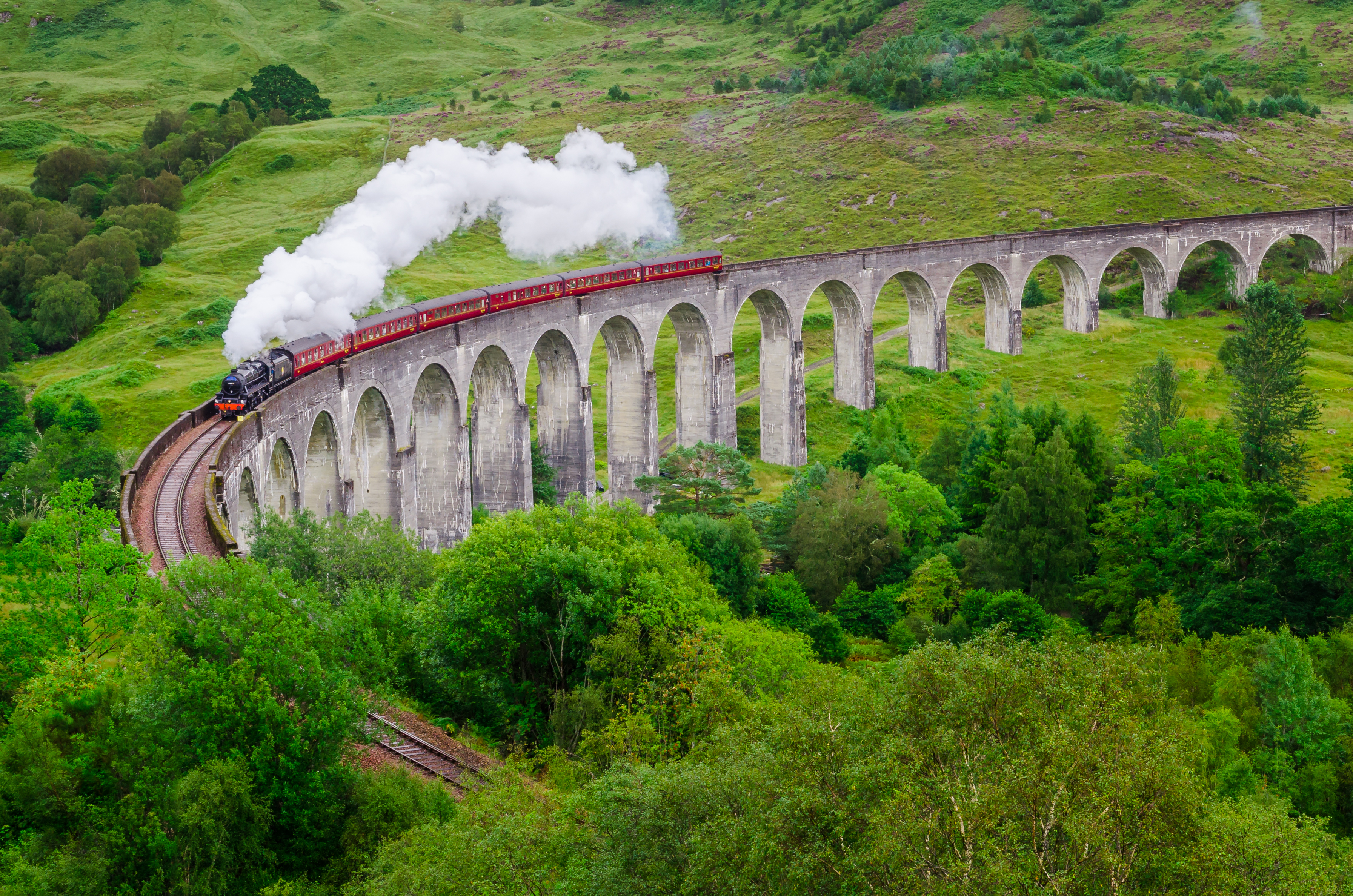
Scotland’s most influential newspapers are The Scotsman, published in Edinburgh, and The Herald, published in Glasgow. Scotland receives radio and television programs from the British Broadcasting Corporation. Commercial radio and television stations also broadcast throughout Scotland.
Tourism.
Scotland’s beautiful scenery and vigorous cultural life attract many tourists. The tourist industry now makes an important contribution to the economy in both urban and rural areas, but especially in Edinburgh and such Highland towns as Inverness and Fort William.
